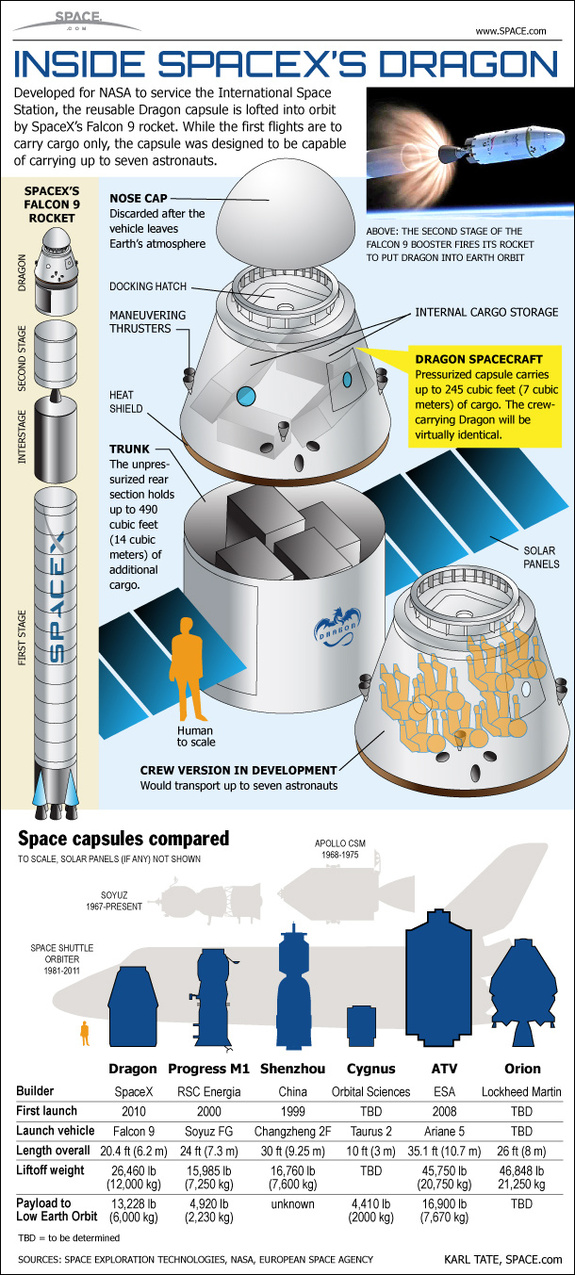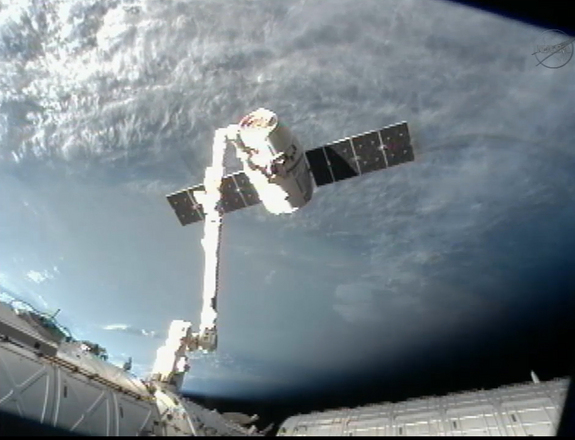
The capsule will begin its scheduled three-week-long stay at the orbiting space station. Image released March 3, 2013.
Credit: NASA
The Dragon spacecraft, operated by California-based Space Exploration Technologies (SpaceX), carries cargo to the International Space Station under commercial agreements the company has with NASA. It was the first private spacecraft to berth with the ISS. SpaceX is also developing a human-rated version to eventually bring astronauts to the space station.
The company made its first demonstration flight to the station in May 2012, and then began commercial fights that fall. SpaceX is currently contracted with NASA to do 12 robotic supply flights to the station for a minimum of $1.6 billion.
While SpaceX is busy ferrying cargo to and from the station, the company is also working on a plan to put astronauts on the Dragon spacecraft. In 2014, the company received $2.6 billion from NASA for the latest phase of the Commercial Crew Program, which aims to fly astronauts on American spacecraft by 2017.
Dragon development
Roll the clock back to 2002, when SpaceX was founded, and you can see how much perceptions of private spaceflight have changed. SpaceX founder Elon Musk has said he named the Dragon spacecraft after the song “Puff, the Magic Dragon,” a 1960s tune from folk group Peter, Paul and Mary.
Musk chose the name, he said, because critics considered his business plan impossible when he founded SpaceX. In fact, Musk and SpaceX kept Dragon’s first 18 months of development secret as the company publicly developed its light Falcon 1 and heavy-lift Falcon 9 rockets .

A look inside the SpaceX Dragon capsule and its Falcon 9 rocket.
Credit: Karl Tate/SPACE.com
The news became public in March 2006 after SpaceX and several teammates submitted a proposal for NASA’s Commercial Orbital Transportation Services (COTS) demonstration program. NASA accepted the SpaceX proposal, and that of another company, in August 2006.
What SpaceX proposed to do was fly the Dragon spacecraft on three Falcon 9 rocket flights — a rocket that was still under development. At the time, SpaceX planned to fly those flights in the 2008-09 timeframe, but the design, approval and milestone process took years longer than anticipated.
Dragon passed a NASA critical design review in October 2007, marking a key milestone, as this is when the shape of the spacecraft is determined. The next month, SpaceX broke ground for a launch site at Cape Canaveral Air Force Station. This would be the launching pad for Falcon 9 and Dragon, when the time was right.
Flurry of flight activity
As Dragon development moved forward, NASA offered more funding in several forms. In April 2008, NASA awarded SpaceX a launch services contract.
Dubbed “indefinite delivery/indefinite quality,” the pact allowed for NASA to order anywhere between $20,000 and $1 billion worth of launches from SpaceX through December 2012. “[SpaceX] can compete for NASA missions using the Falcon 1 and Falcon 9 launch vehicles,” the firm stated .
Then came a large breakthrough. In December 2008, NASA selected Space X’s Falcon 9/Dragon combination for cargo resupply to the International Space Station. The contract was for a minimum of $1.6 billion, with the option to extend services to up to $3.1 billion. Musk stated it was a “tremendous responsibility” for SpaceX, given the approaching retirement of the shuttle program at the time.
The firm placed some communications hardware on the STS-129 shuttle flight in November 2009 to assist with future SpaceX flights to the station. SpaceX launched the Falcon 9 rocket for the first time in June 2010. This flight included a “qualification unit” of the Dragon spacecraft that was primarily supposed to transmit data during its ride into space.
With the test unit successfully flown, SpaceX turned its attention to sending the real thing. The first full-up test of the Dragon spacecraft came on Dec. 8, 2010. The mission was a success . It marked the first time a private unmanned space capsule was recovered safely back on Earth.

The private Dragon capsule built by SpaceX is seen at the end of the International Space Station’s robotic arm during its undocking on Oct. 28, 2012, in this camera view. The Dragon capsule made the first commercial cargo delivery to the space station for NASA.
Credit: NASA TV
Achieving berthing
With the world watching, SpaceX prepared to send the first cargo demonstration flight to the station in May 2012. An abort took place after a problem was detected in one of the engines, pushing back the launch a few days. The spacecraft made it into orbit on May 22.
Three days later, Dragon made its final approach to the station. The spacecraft experienced some problems with its laser distance-judging system when the laser got “distracted” and began bouncing signals off the wrong part of the station. SpaceX controllers then narrowed Dragon’s view, and the approach proceeded.
Dragon’s first official supply run took place in October 2012. While the spacecraft made it into orbit safely, Falcon 9 experienced a problem with one of its rocket engines during flight. SpaceX adjusted the trajectory of the rocket to put Dragon on the right path. Dragon berthed with the station, and then splashed down successfully weeks later in the Pacific Ocean near California.
One Dragon spacecraft was lost en route to the International Space Station in 2015 when the Falcon 9 rocket carrying it failed, causing a catastrophic explosion. Space station flights were delayed by several months while SpaceX addressed the underlying problem. Cargo flights resumed in 2016.
While Dragon flights make periodic cargo trips to the International Space Station, SpaceX is also working on a human-rated version for NASA’s Commercial Crew Program. The company unveiled its design for the crewed spacecraft in 2014 to great fanfare, but many safety tests must be passed before it can carry astronauts.
The vehicle can hold up to seven astronauts, as opposed to the current manifest limit of three on Soyuz spacecraft. SpaceX and NASA are hoping this capability will allow International Space Station crews to expand from the current normal level of six people. Commercial crew flights are expected to begin around 2017 or 2018.
Additional resources

Comments are closed.